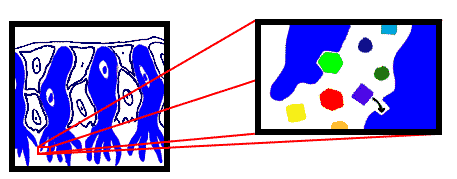In the previous Olfaction exercises, you have experienced both
"good" and "bad" smells. No doubt some of them have been most memorable......cadaverine,
putrescine, oil of wintergreen, sweet esters?
Although not necessarily good or bad, the difference in smell between the
isomers of carvone is also memorable and most remarkable....mint and caraway!
Identification and visualization of d- and l- carvone's molecular
structures,
comparison
to
their
physical properties,
and relating back to the concepts of enzyme "docking" will complete the
introduction
to the
molecular
theory of smell. The fundamentals
of
the
theory
of smell can readily be extended to the process and relationship of smell to
memory
and
learning.

The University of Western Michigan includes advice to its students that
suggests that an olfactory learning style is a potential approach for students
to consider for adoption since smell assists memory . This is not so remarkable.
Marcel
Proust (1871-1922), a French writer whose main themes were memory and
guilt, said "smell helps us in the search for the past."
Perhaps bringing a sample of carvone to the next hour exam will trigger
recall of the organic chemistry that you have been introduced to. Consider
it and please report your findings to me if you use it.
Using jmol compare the two images below.
Identify d-carvone and l-carvone. If you cannot visualize
the differences on screen, make exact models of each with your model kit and
follow
your manipulations with the hand held models.
Position both d- and l- isomers on their respective screens
so that you can clearly see that they are different.
Although d- and l- carvone appear very similar, they are different structures.
Identify (A) and (B) as d- or l-.
The structures are mirror images (enantiomers) and are not stereochemically
identical.
The differences in their stereochemistry accounts for the difference in
their smells. As you have seen, the tissue surface in the nose has protein
receptors with uniquely
shaped cavities, referred to as active sites, that respond to the shape and
fit of the carvone isomers. An extremely rough approximation is provided
below from the
Pacific Science Center's graphic of the cilia in your nose and the molecular
fit of the different shapes of odor molecules: (Graphic is taken from the
Pacific Science Center's Page on Smell.)

For carvone, one receptor gives the sense of mint and another receptor the
sense of caraway. See the index for numerous odors and compounds in the
Flavornet
site linked from: Web references and links.
This type of a chemical interaction between a large "macro" molecular
protein (enzyme) and a small organic molecule (substrate) is repeated again
and again in all living species and in all aspects of life, whether it is
our senses: smell, vision, thinking, feeling or more basic functions: eating
and sleeping or illness: AIDs or therapies, such as treating bacterial infections.
Modern science employs visualizations to understand enzyme:substrate (receptor:ligand)
interactions (docking) and to make predictions on what substrates might effect
an enzyme based on their relative shapes and functionality. Web MO is an
example of the technology
that is the general basis for doing these exacting visualizations, you will
be able to generate certain
molecules and molecular
views
which
will roughly approximate the process and provide a glimpse into
the frontiers of research.
Optical Rotation:
Draw both of the isomers on the Worksheet form that
you are to turn in. Use (to
indicate bonds going back from the page), use
(to
indicate bonds going back from the page), use (to
indicate bonds coming out of the page) and use a solid line to indicate
bonds in the plane of the page.
(to
indicate bonds coming out of the page) and use a solid line to indicate
bonds in the plane of the page.
Do d- and l- isomers of carvone have different physical
properites? For each, what
is the respective boiling point, melting point, density or specific gravity,
flash
point, solubility,
refractive
index and optical rotation for each form? These can be found through ChemFinder
on the Web, the Merck Index
and the CRC Handbook.
© Copyright 1997-2008 R.J. Rusay


